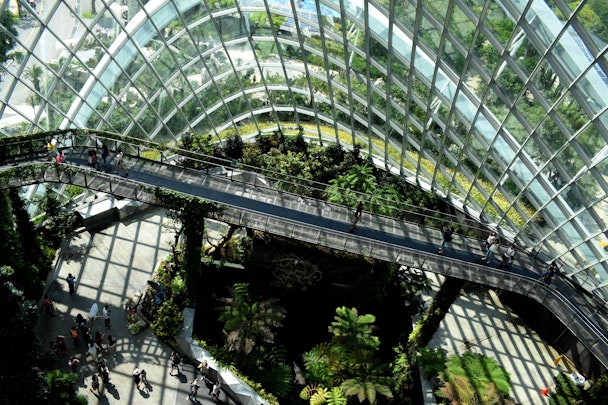Time for the web to tidy up: reducing digital’s carbon impact
With a staggering 1.9bn websites in existence and ballooning asset sizes for ads and webpages, digital now accounts for more carbon emissions than the aviation industry. As part of The Drum’s Digital Advertising Deep Dive, Siji Onabanjo of digital transformation agency Cyber-Duck looks at why – and how – we can tidy up the web to benefit business and the planet.

Cyber-Duck on the financial and ecological benefits of prioritizing sustainability in business
In 1992 there were 10 websites in existence. In 2022, there are a staggering 1.9bn, with 56.5bn webpages indexed by Google and 250,000 new sites created every day (although only 200m are active).
Websites are also getting bigger. The average page weight is around two megabytes or more – over 150 times larger than 1995 – often meaning a slow-loading, poor user experience (UX).
This results in vast amounts of carbon emissions generated by hosting websites in hyperscale data centers. Digital now has a greater share of GHG emissions than aviation (equivalent to the seventh largest country in the world) and it’s growing exponentially. For marketers whose organizations are focused on tackling climate change while delivering a great customer experience (CX), it’s time to look at their digital carbon footprint and tidy the web of obsolete, polluting stuff.
How did the web get so messy?
It’s like plastic pollution. One plastic bottle isn’t a problem, but a vast single-use plastic ecosystem with no recycling is. The web ecosystem has grown in the same way, without thought about environmental implications.
Organizations build new websites and microsites when their old ones fail to support emerging functionality or business areas (many have separate e-commerce sites, for example). Typically, new pages are added, but rarely removed. For many organizations, this makes a sprawling, unproductive mess, with outdated, replicated content that’s hard to find and user journeys that go nowhere. We’ve worked on websites that have tens of thousands of URLs.
Website size has increased due to the proliferation of formats such as audio, video and image files that typically make up around 50% of pages’ weight. An ironic example is the UN Cop26 website’s homepage: a massive 8.8MB, over four times the average, largely due to JavaScript from embedded social media feeds and a 3MB image footer.
This is compounded by how the website is coded and configured for data transfer (what website data is retrieved and sent to a user’s device) and where the site is hosted (most data centers in the US and China are energy-inefficient and powered by fossil fuels, while many in Europe use renewable sources).
Tidying up on all fronts is essential.
‘Reduce, reuse, recycle’ also applies to digital
Just like plastic packaging, reduction is the place to start. Website consolidation – reducing the sheer number and size of websites; combining them on to fewer, user-centric platforms – is critical. That will give sustainability benefits and cost savings (fewer software licenses and hosting costs) but also improve UX. We often use an open-source CMS Drupal that can support multiple languages, sub-brands, products and accompanying design differentiation from one back-end system.
Large-scale website consolidation requires a holistic service design-led and user-centered design approach: establishing the systems, technologies, processes and CX required as part of the end-to-end journey of the product/service. This includes undertaking detailed research into legacy sites’ users, what content they want to find and what actions they want to complete, and then carrying out a content audit of the various sites – identifying duplicated (or triplicated), outdated or missing content.
Next, use these insights to generate an information architecture and crystal-clear user interface with well-written content and clearly signposted user journeys for the new consolidated site. That helps users find what they need, reducing cases where they click fruitlessly around, loading and re-loading pages, or downloading the wrong assets entirely – all causing unnecessary carbon emissions. This approach also slims down large, sprawling, single websites.
Optimize everything
With users put off by slow-loading sites, speeding sites up has both environmental and UX benefits.
The minimalist approach says to only add in things critical to the site, clean coded with miminal JavaScript, to keep it high-performing. Choose smaller vector graphics and CSS effects instead of jpegs and gifs. Compress images at the correct scale to reduce file size without losing quality.
In the case of the Cop26 website, the 3MB footer image was reduced to 462 kB with no visual impact. Minimize custom font use and use modern web fonts such as WOFF/WOFF2. Avoid autoplay on videos and audio, prompting users to click if they’re interested. Implement caching solutions that reduce the amount of data transferred per visit. And look to green hosting and local Content Delivery Networks (CDNs) to store and serve sites more sustainably.
Sustainability means better SEO
The best thing for marketers is that sites with great UX, content and performance have great ‘core web vitals’ – which factor into Google Search rankings. And, given Google is already prioritizing search results for eco-friendly information and products, it might not be long before it ranks sustainably-designed and -hosted websites higher.
A win-win for business and the planet.
Read more from The Drum’s latest Deep Dive over at our Digital Advertising hub.
Content by The Drum Network member:

Cyber-Duck
Established in 2005, Cyber-Duck is a leading digital agency that works with exciting startups and global brands such as Cancer Research Technology, The European...
Find out more
